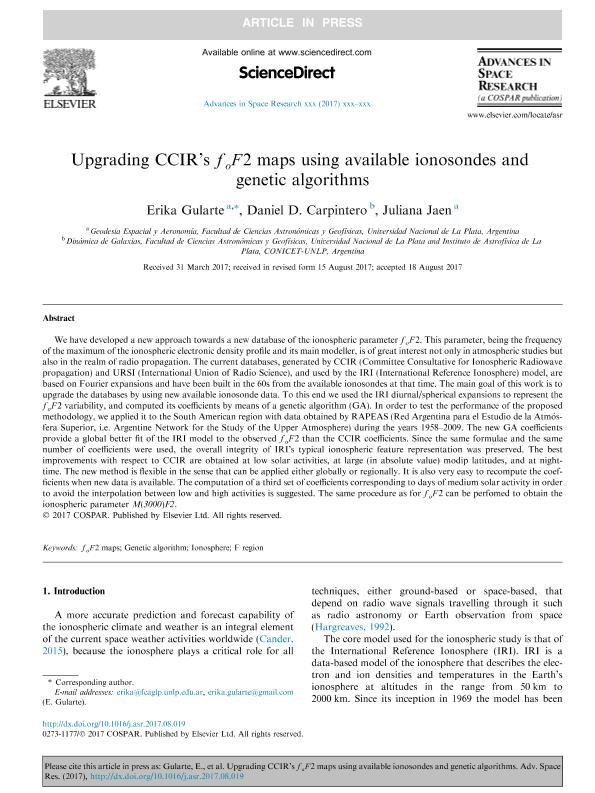Mostrar el registro sencillo del ítem
dc.contributor.author
Gularte Scarone, Angela Erika

dc.contributor.author
Carpintero, Daniel Diego

dc.contributor.author
Jaen, Juliana María

dc.date.available
2018-03-26T15:21:06Z
dc.date.issued
2018-04
dc.identifier.citation
Gularte Scarone, Angela Erika; Carpintero, Daniel Diego; Jaen, Juliana María; Upgrading CCIR's foF2 maps using available ionosondes and genetic algorithms; Elsevier; Advances in Space Research; 61; 7; 4-2018; 1790-1802
dc.identifier.issn
0273-1177
dc.identifier.uri
http://hdl.handle.net/11336/39900
dc.description.abstract
We have developed a new approach towards a new database of the ionospheric parameter foF2. This parameter, being the frequency of the maximum of the ionospheric electronic density profile and its main modeller, is of great interest not only in atmospheric studies but also in the realm of radio propagation. The current databases, generated by CCIR (Committee Consultative for Ionospheric Radiowave propagation) and URSI (International Union of Radio Science), and used by the IRI (International Reference Ionosphere) model, are based on Fourier expansions and have been built in the 60s from the available ionosondes at that time. The main goal of this work is to upgrade the databases by using new available ionosonde data. To this end we used the IRI diurnal/spherical expansions to represent the foF2 variability, and computed its coefficients by means of a genetic algorithm (GA). In order to test the performance of the proposed methodology, we applied it to the South American region with data obtained by RAPEAS (Red Argentina para el Estudio de la Atmósfera Superior, i.e. Argentine Network for the Study of the Upper Atmosphere) during the years 1958–2009. The new GA coefficients provide a global better fit of the IRI model to the observed foF2 than the CCIR coefficients. Since the same formulae and the same number of coefficients were used, the overall integrity of IRI's typical ionospheric feature representation was preserved. The best improvements with respect to CCIR are obtained at low solar activities, at large (in absolute value) modip latitudes, and at night-time. The new method is flexible in the sense that can be applied either globally or regionally. It is also very easy to recompute the coefficients when new data is available. The computation of a third set of coefficients corresponding to days of medium solar activity in order to avoid the interpolation between low and high activities is suggested. The same procedure as for foF2 can be perfomed to obtain the ionospheric parameter M(3000)F2.
dc.format
application/pdf
dc.language.iso
eng
dc.publisher
Elsevier

dc.rights
info:eu-repo/semantics/openAccess
dc.rights.uri
https://creativecommons.org/licenses/by-nc-sa/2.5/ar/
dc.subject
F Region
dc.subject
Fof2 Maps
dc.subject
Genetic Algorithm
dc.subject
Ionosphere
dc.subject.classification
Meteorología y Ciencias Atmosféricas

dc.subject.classification
Ciencias de la Tierra y relacionadas con el Medio Ambiente

dc.subject.classification
CIENCIAS NATURALES Y EXACTAS

dc.title
Upgrading CCIR's foF2 maps using available ionosondes and genetic algorithms
dc.type
info:eu-repo/semantics/article
dc.type
info:ar-repo/semantics/artículo
dc.type
info:eu-repo/semantics/publishedVersion
dc.date.updated
2018-03-26T14:39:38Z
dc.journal.volume
61
dc.journal.number
7
dc.journal.pagination
1790-1802
dc.journal.pais
Países Bajos

dc.journal.ciudad
Amsterdam
dc.description.fil
Fil: Gularte Scarone, Angela Erika. Universidad Nacional de la Plata. Facultad de Ciencias Astronómicas y Geofísicas. Grupo de Geodesia Espacial y Aeronomia; Argentina
dc.description.fil
Fil: Carpintero, Daniel Diego. Consejo Nacional de Investigaciones Científicas y Técnicas; Argentina. Universidad Nacional de La Plata. Facultad de Ciencias Astronómicas y Geofísicas; Argentina
dc.description.fil
Fil: Jaen, Juliana María. Universidad Nacional de la Plata. Facultad de Ciencias Astronómicas y Geofísicas. Grupo de Geodesia Espacial y Aeronomia; Argentina
dc.journal.title
Advances in Space Research

dc.relation.alternativeid
info:eu-repo/semantics/altIdentifier/doi/http://dx.doi.org/10.1016/j.asr.2017.08.019
dc.relation.alternativeid
info:eu-repo/semantics/altIdentifier/url/https://www.sciencedirect.com/science/article/pii/S0273117717306142
Archivos asociados
